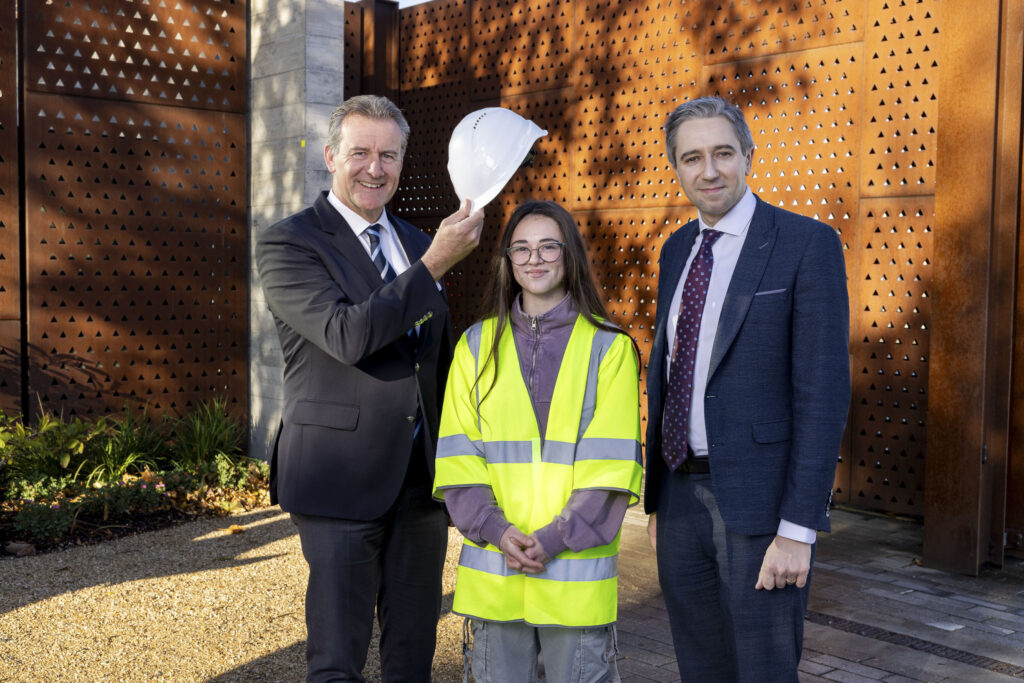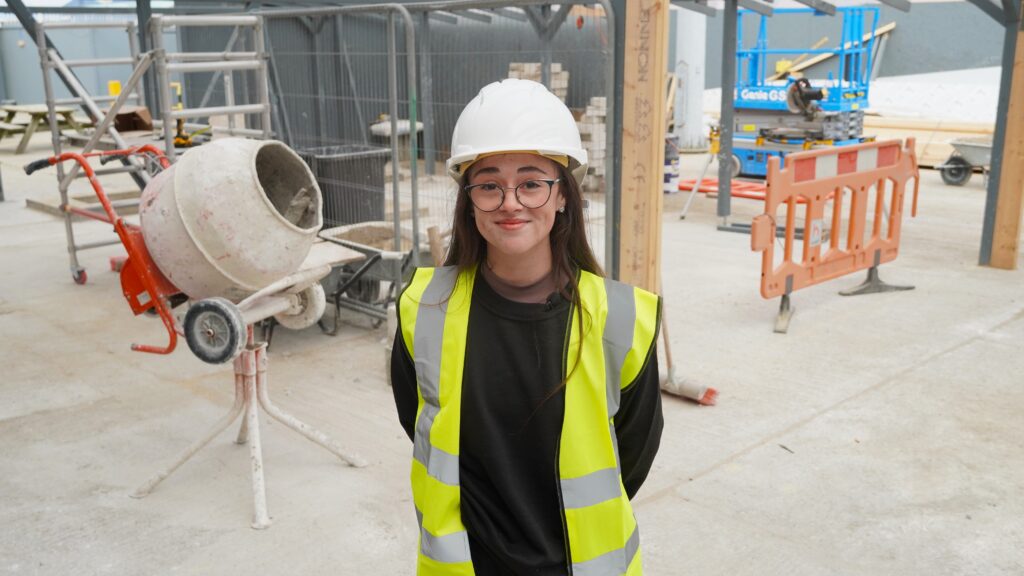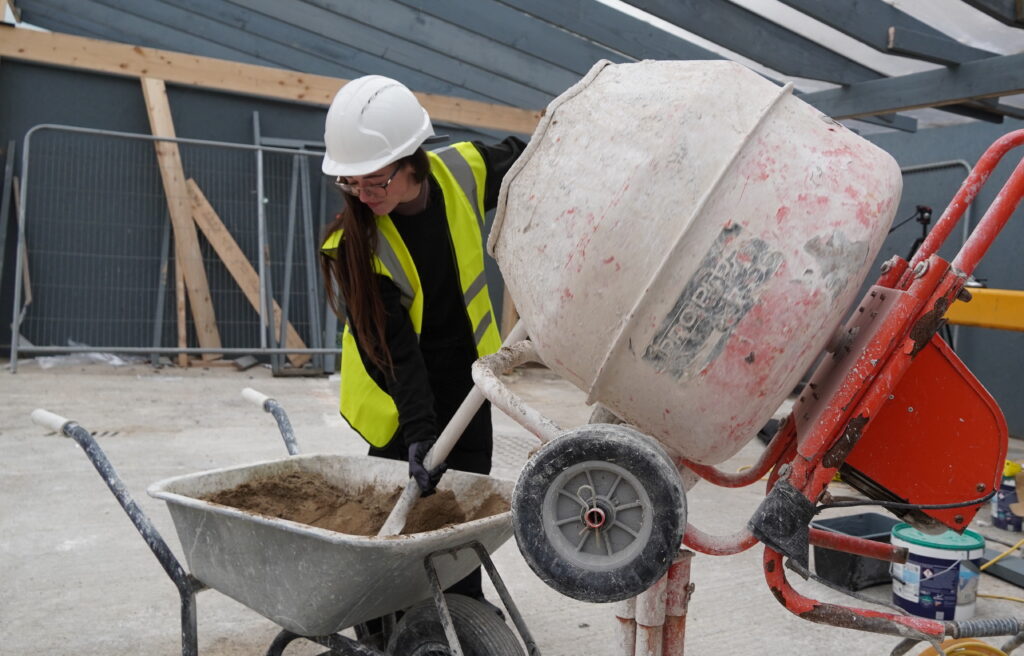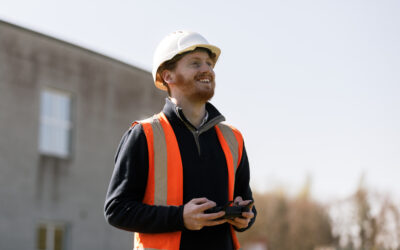Pictured above is Graduate of the Dublin Port-based course in Construction Skills Megan Pepper and Edel Currie, Community Engagement Manager at Dublin Port Company, celebrating the course crossing a milestone of 1,000 graduates since its inception in 2017. The three-week course, which is ran by St Andrew’s Resource Centre in partnership with Inner City Renewal Group, is focused on helping unemployed upskill quickly and find gainful employment in the construction industry.
Training, skills and education are the cornerstone of any successful industry. Aidan Priestley reports
At the heart of St Andrews Resource Centre lies a mission to offer education and training, providing pathways to various services and opportunities.
Spearheaded by a team of guidance workers, the centre has been instrumental in delivering courses like the construction skills programme, celebrating over 1,000 graduates since its launch in 2017.
Jim Hargis, Education and Training Hub Manager at St Andrews Resource Centre, on Dublin’s Pearse Street, emphasises the focus on transforming education into tangible economic outcomes.
“Education and training lead to better economic outcomes,” he says, highlighting that over 60 per cent of course graduate secure new employment within a month, a statistic that speaks volumes about the programme’s effectiveness.
The programme’s ethos is clear, to equip individuals with the essentials needed to thrive in the construction industry. From providing Personal Protective Equipment (PPE) to imparting the requisite skills and fostering work discipline, the course aims to prepare individuals for the rigors of construction work.
But it’s not just about creating top-notch construction workers, it’s about fostering team players. “We’re not looking for the best construction workers necessarily, we’re looking for the guys who would be part of a team,” Jim says, emphasising the importance of camaraderie and collaboration within the industry.

Minister for Further and Higher Education Simon Harris TD with Megan Pepper, graduate of the Dublin Port-based Construction Skills course, and Barry O’Connell, Chief Executive at Dublin Port. Photo: Conor Healy
Encouraging progress
The course’s methodology revolves around a blend of classroom learning and hands-on experience. “Some people learn by doing rather than seeing,” Jim says.
The programme caters to diverse learning styles, ensuring that literacy barriers don’t impede progress.
“That’s not a big problem for us, we can walk the guys through what a 45-degree angle is to make a square frame,” he adds,
underlining their commitment to inclusive teaching.
Starting with fundamental skills like manual handling and site safety, the course covers a spectrum of trades, from carpentry to block work, plumbing, use of hand tools and more.
“We move people through the project at an unparalleled speed,” Jim says, highlighting the focus on efficient learning and quick job placement.
Yet, it’s not about unrealistic promises or forcing change upon individuals.
“We’re not standing over them and demanding anything, they have to want to do it for themselves,” he says. Jim clarifies that the centre provides an opportunity, but the initiative and commitment ultimately rests with the individuals.
The success stories speak volumes.
“We’ve had people come into us having been out of work for 27 years, and they get work after,” Jim shares, underscoring that the programme is open to all willing to take that step forward.
Looking ahead, he anticipates a future with even more success stories.
With plans to graduate another 1,000 individuals in 2024 alone, St Andrews Resource Centre remains steadfast in its commitment to empowering individuals and offering viable pathways into the workforce.

Megan Pepper, a recent Construction Skills graduate, at Dublin Port. Photo: Cian Geoghegan
Evolving landscape
Megan Pepper, at 20 years old, is one such recent graduate from the course. She has always been drawn to trades, partly because of her family background.
“I’ve always wanted to get into a trade since I was young,” she says. “It runs in the family, I’ve always gotten a chance to put my hands to it, so I’ve always enjoyed it. My dad is a brick, block and stone mason by trade.”
Describing her course, Megan loved how hands-on it was, giving a taste of different trades.
“The course is great, you do everything, you’re literally getting a try at almost every trade,” she adds. “So, you just paint, wallpaper, you build up a stud wall, you get to do a bit of block work, brick work. You do plumbing too, which is very good.”
She’s all for more people, especially girls, getting into trades.
“The course is brilliant and it’s growing to get more people into it, and I fully back that,” she says. “I back more females getting into trades and how it should be spoken about more.”
“It’s starting to change a bit because you can see even in the course there’s a few more girls showing up,” she says, hopeful about the evolving landscape.
Her school didn’t offer much in terms of exploring trades, being an all-girls school.
“We only had home economics,” she explains. “I would have loved to have done, even Technical Graphics in school, if they had done technical drawing or anything like that, I would have jumped at that opportunity.
“I completely finished school but it wasn’t until later that I could really look into going into building” she adds. “But then Covid hit obviously, so I couldn’t really do that.”

Megan Pepper is a recent Construction Skills graduate. Pictured here at Dublin Port. The port-based three-week course, which is ran by St Andrew’s Resource Centre in partnership with Inner City Renewal Group, is focused on helping unemployed upskill quickly and find gainful employment in the construction industry. Photo: Cian Geoghegan
She believes the pandemic shifted how people thought about careers. “Covid made everyone think about office jobs rather than hands-on work,” she says. However, for those who are thinking about going into trades Megan is clear in her advice.
“Go for it, you won’t know if you like it, if you don’t try it,” she adds.
It’s the same advice she’s giving her younger sibling. “I’m pushing my little sister in now,” she says. “She’s only eight so hopefully she’ll be ready when the time comes.”








